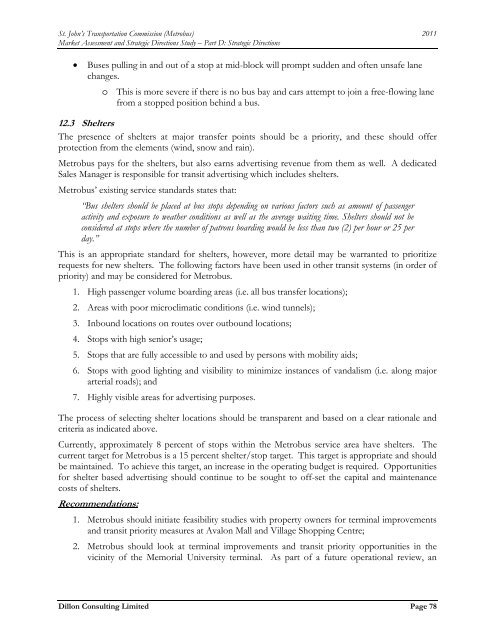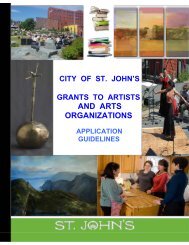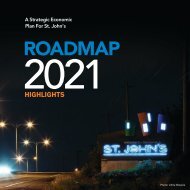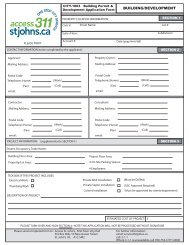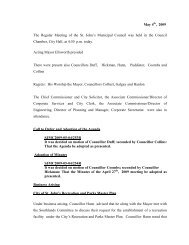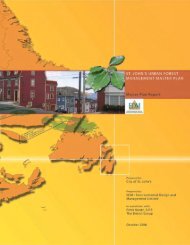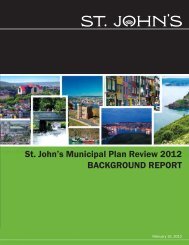Metrobus Transit Study.pdf - City of St. John's
Metrobus Transit Study.pdf - City of St. John's
Metrobus Transit Study.pdf - City of St. John's
You also want an ePaper? Increase the reach of your titles
YUMPU automatically turns print PDFs into web optimized ePapers that Google loves.
<strong>St</strong>. John’s Transportation Commission (<strong>Metrobus</strong>) 2011<br />
Market Assessment and <strong>St</strong>rategic Directions <strong><strong>St</strong>udy</strong> – Part D: <strong>St</strong>rategic Directions<br />
<br />
Buses pulling in and out <strong>of</strong> a stop at mid-block will prompt sudden and <strong>of</strong>ten unsafe lane<br />
changes.<br />
o This is more severe if there is no bus bay and cars attempt to join a free-flowing lane<br />
from a stopped position behind a bus.<br />
12.3 Shelters<br />
The presence <strong>of</strong> shelters at major transfer points should be a priority, and these should <strong>of</strong>fer<br />
protection from the elements (wind, snow and rain).<br />
<strong>Metrobus</strong> pays for the shelters, but also earns advertising revenue from them as well. A dedicated<br />
Sales Manager is responsible for transit advertising which includes shelters.<br />
<strong>Metrobus</strong>’ existing service standards states that:<br />
“Bus shelters should be placed at bus stops depending on various factors such as amount <strong>of</strong> passenger<br />
activity and exposure to weather conditions as well as the average waiting time. Shelters should not be<br />
considered at stops where the number <strong>of</strong> patrons boarding would be less than two (2) per hour or 25 per<br />
day.”<br />
This is an appropriate standard for shelters, however, more detail may be warranted to prioritize<br />
requests for new shelters. The following factors have been used in other transit systems (in order <strong>of</strong><br />
priority) and may be considered for <strong>Metrobus</strong>.<br />
1. High passenger volume boarding areas (i.e. all bus transfer locations);<br />
2. Areas with poor microclimatic conditions (i.e. wind tunnels);<br />
3. Inbound locations on routes over outbound locations;<br />
4. <strong>St</strong>ops with high senior’s usage;<br />
5. <strong>St</strong>ops that are fully accessible to and used by persons with mobility aids;<br />
6. <strong>St</strong>ops with good lighting and visibility to minimize instances <strong>of</strong> vandalism (i.e. along major<br />
arterial roads); and<br />
7. Highly visible areas for advertising purposes.<br />
The process <strong>of</strong> selecting shelter locations should be transparent and based on a clear rationale and<br />
criteria as indicated above.<br />
Currently, approximately 8 percent <strong>of</strong> stops within the <strong>Metrobus</strong> service area have shelters. The<br />
current target for <strong>Metrobus</strong> is a 15 percent shelter/stop target. This target is appropriate and should<br />
be maintained. To achieve this target, an increase in the operating budget is required. Opportunities<br />
for shelter based advertising should continue to be sought to <strong>of</strong>f-set the capital and maintenance<br />
costs <strong>of</strong> shelters.<br />
Recommendations:<br />
1. <strong>Metrobus</strong> should initiate feasibility studies with property owners for terminal improvements<br />
and transit priority measures at Avalon Mall and Village Shopping Centre;<br />
2. <strong>Metrobus</strong> should look at terminal improvements and transit priority opportunities in the<br />
vicinity <strong>of</strong> the Memorial University terminal. As part <strong>of</strong> a future operational review, an<br />
Dillon Consulting Limited Page 78


